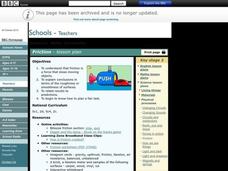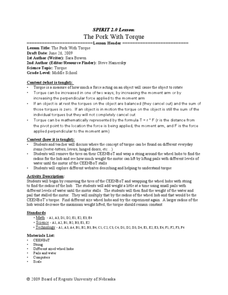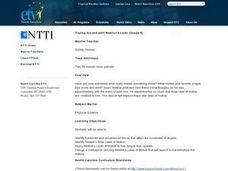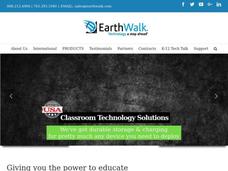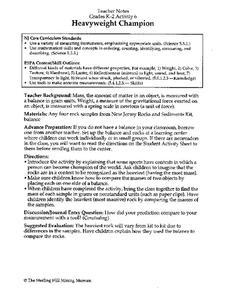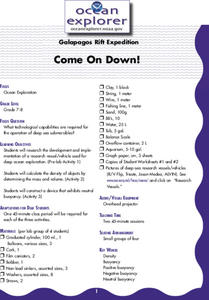Curated OER
Forces and Pressure
In this forces worksheet, students will review the different types of forces and how forces are measured. This worksheet has 9 fill in the blank, 1 short answer, and 11 multiple choice questions.
Curated OER
Density and Buoyancy Lesson Plan
Students investigate why some objects float or sink in water. In this physics lesson, students calculate the density of clay ball using a mathematical equation. They write a complete lab report about the experiment.
Curated OER
Friction
Students review what force. In this science lesson, students determine which surfaces are rough and which are smooth by observing how an object moves on each surface.
Curated OER
MEASURING THE GRAVITATIONAL CONSTANT, G
Students study gravitational force an. In this gravitational force lesson plan students observe a demonstration.
Curated OER
Support Forces and Equilibrium Worksheet
In this equilibrium activity, students complete 10 multiple choice and fill in the blank questions about mechanical equilibrium and the support forces involved.
Curated OER
Measurement: Using the balance
Students use a balance and gram cubes to measure several different objects. They then record their results on a data chart and answer questions about them.
Curated OER
First Class Lever Lab
In this first class lever worksheet, students investigate the mechanical advantage of this simple machine. Students change the effort arm and the resistance arm and calculate the resistance force, effort force and the mechanical...
Curated OER
Perching Parrot
Students explore the concepts of center of mass and static equilibrium by seeing how non-symmetrical objects balance. They also analyze why all forces on an object must cancel out exactly for an object to be stationary.
Curated OER
Avalanche!
Students explain that when forces on an object are balanced, the motion of object does not change. They describe how an object changes its motion when forces on it are unbalanced. They plan and conduct a scientific investigation to test...
LABScI
Harmonic Motion: Pendulum Lab
Several times throughout history, groups of soldiers marching in rhythm across a suspension bridge have caused it to collapse. Scholars experiment with pendulums, resonance, and force to determine why this would happen. First, pupils...
LABScI
Viscosity: The Fluid Lab
There's more to fluids than meet the eye—they include gases, liquids, and polymers, too! Scholars complete three hands-on activities exploring different properties of fluids. They explore viscosity by measuring the resistance, or...
NASA
Newton Car
If a car gets heavier, it goes farther? By running an activity several times, teams experience Newton's Second Law of Motion. The teams vary the amount of weight they catapult off a wooden block car and record the distance the car...
Curated OER
Tightrope Trials
Students research the concepts of center of mass and how to make different things balance. They make symmetrical cut-outs of different "creatures" and experiment with how they balance on a tightrope of string.
Curated OER
Flight Physics
Students apply the knowledge of Bernoulli's Principle and construct simple aerodynamic designs. In this flight physics lesson, students explore the history of man's interest in flying and the forces influencing an object in flight by...
Cornell University
Buoyancy
Swimmers know to float by turning their bodies horizontally rather than vertically, but why does that make a difference? In an interesting lesson, scholars explore buoyancy and the properties of air and water. They test cups to see which...
K12 Reader
Why Does the Moon Orbit Earth?
Have you ever looked up at the moon and wondered why it looks different every night? Learn about the moon's orbit and the lunar cycle with a reading comprehension exercise. Using context clues, kids find the definitions of unfamiliar...
Curated OER
The Pork With Torque
Students determine the torque of CEENBoTs wheel hub. In this physics lesson, students reinforce their learning by exploring interactive websites on torque. They give real life applications of torque.
Curated OER
Toying Around with Newton's Laws
Eighth graders identify balanced and unbalanced forces that affect the movement of objects and Newton's three Laws of Motion. Students also design a contraption utilizing Newton's Laws of Motion that will launch a marshmallow five meters.
Curated OER
Seesaws
Students make direct comparisons between objects using balance and spring scales. They also are encouraged to estimate which object is heavier by holding the objects before using the balance scales. Comparing the masses of objects is the...
Curated OER
Newton's 3 Laws of Motion
In this Newton's 3 laws of motion worksheet, students view examples of each law and draw 1 example of each law on their own. Students draw 3 pictures.
Curated OER
Building Bridges
Students identify the different types of bridges. Using the internet, they research information on how they are built by completing a scavenger hunt. Locating a specific area, they determine which type of bridge would be appropriate and...
Curated OER
Balanced Students
High schoolers investigate the relationships between weights, and construct a balanced first class lever. They formulate a general equation for the relationship explored in the experiment and perform calculations.
Curated OER
Heavyweight Champion
Students identify what mass is and how to measure an object with a balance in gram units. Students identify weight and how to measure with a spring scale in units of force. Students compare the masses of two objects by placing each on...
Curated OER
Galapagos Rift Expedition Come On Down!
Students research the development and implementation of a research vessel/vehicle used for deep ocean exploration. In this oceanography lesson, students calculate the density of objects by determining the mass and volume.




